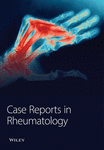A Rare Case of Acute Methotrexate Toxicity Leading to Bone Marrow Suppression
Abstract
Methotrexate is a first-line disease modifying antirheumatic drug used for the treatment of inflammatory arthritis. Bone marrow suppression is a common adverse reaction of methotrexate following its long-term use. However, low dose methotrexate is rarely associated with life-threatening bone marrow suppression. This case represents an atypical presentation of acute bone marrow suppression shortly after initiating treatment with low-dose methotrexate. A 76-year-old male patient presented with oral ulcers, poor oral intake, and acute kidney injury within 3 weeks of initiating 15 mg weekly of methotrexate for seronegative rheumatoid arthritis. Complete blood count was suggestive of pancytopenia with hemoglobin of 10.8 g/dL, total white cell count 3.36 (1000/uL) (absolute neutrophil count 490 micro/L), platelets 19,000, serum albumin 3.1 g/dL, ESR elevated at 83 mm/hr, CRP elevated at 86.6 mg/L, and ferritin mildly elevated at 625 ng/mL. Peripheral blood smear showed signs of bone marrow suppression but no signs of hemolysis or inflammation. Serum methotrexate levels were minimally detectable at 0.05 umol/L. Methotrexate was held, within 48 hours of admission; his WBC dropped to 1.48, Hgb 9.9, and platelets 15,000. ANC reached a nadir of 220. He was treated with broad spectrum antibiotics, high-dose folic acid, fluconazole for oral thrush, and intravenous bicarbonate and leucovorin supplementation, dosed at PO 20 mg daily. On day 7, his blood count showed improvement along with improvement in his symptoms. The patient was discharged home on day 8th of hospitalization and upon one month follow-up in rheumatology clinic, his complete blood count had normalized. This case highlights multiple risk factors that triggered pancytopenia in our elderly patient, resulting in acute methotrexate toxicity.
Conflicts of Interest
The authors declare that they have no conflicts of interest.




